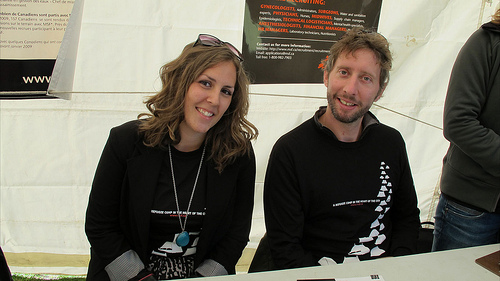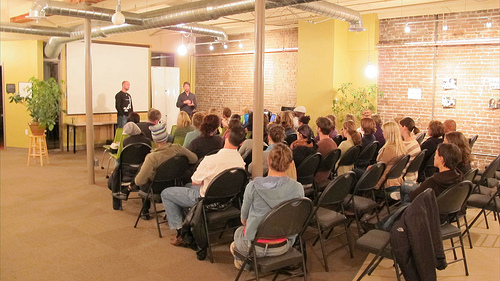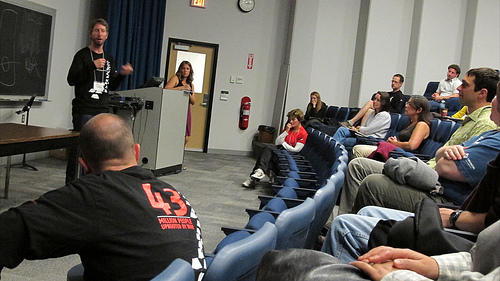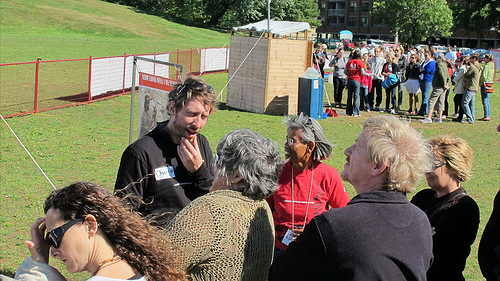Recruitment: Inviting people to ‘live the experience’
Sunday September 18th (Halifax NS) – While the last guided tours wind down, and that the crew gets ready to pack up and head out to Moncton, I think on the last few days spent in Halifax.
Spent Friday afternoon in the exit tent with fellow recruiters Geneviève Bolduc and Owen Campbell (see photo) meeting people interested in possibly volunteering with MSF, informing them about the various recruitment events going on during the week-end. The Refugee Camp tours really get people thinking about the reality of populations in remote areas whose lives have been disrupted. We were there to explain what they can do to become MSF field workers and ‘live the experience’. A lot of people were surprised to find out that they too can volunteer to work with MSF. As I repeated over the course of the week-end, ‘MSF is not just for doctors..’. Of course we are always looking to recruit doctors, surgeons, anaesthesiologists and nurses, but there is also a strong need for non-medical personnel. I think visiting the refugee camp helps people better understand this (especially if their tour guide is a logistician or a water sanitation specialist!). Someone has to set up the camp, make sure the generators are working, make sure that there is water to drink and that the truck engines are working!
We met all kinds of people in Halifax. Some were university students wondering what our selection criteria are, wondering what kind of work experience they would need before eventually applying. Hopefully the spirit of their refugee camp experience will stay with them and we’ll see them again down the road. We also got to speak to people who are thinking about retiring. Whether they be nurses, doctors or electricians, these people represent a great wealth of knowledge and experience. Some have been contemplating volunteering with MSF for some time, but were caught up in their careers or with the challenges of raising a family.
Friday night, the MSF Recruitment department participated actively in the screening of the documentary, ‘Living in emergency’ which was followed by an interesting question and answer period with questions about the recruitment process. On Saturday, we organized special guided tours for doctors, nurses, midwives and technical logisticians contemplating working with MSF in the field. For us, the highlight was definitely the Sunday afternoon information session that was held a 2 PM at Dalhousie University’s Sir Charles Tupper Medical Building. Certain people had registered online several weeks prior to the event. Others had found out about it while attending the Refugee camp exhibit. All listened attentively while Recruitment officer Owen Campbell went through his PowerPoint presentation, taking the time to give a detailed explanation of the MSF recruitment process, using examples of his own personal mission experience in Congo to shed light on the realities of life in the field. Judy Adams, a MSF mental health specialist, was the session’s guest speaker. Judy shared stories of her time in the field and the everyday challenges that await MSF field workers. The official presentation was followed by a question and answer period. The public was then invited to meet with expats from various backgrounds (medical doctor, administrator, logistician) who were present to answer questions specific to each individual’s needs.
There are many ways a person can work with MSF. The Refugee camp in the heart of the city exhibit has proven to be a great way for us to reach people from the Halifax and St-John’s areas. We look forward to meeting potential candidates in Moncton. Please check out the Recruitment events tab on this site. Again, events will include Saturday special tours and a Sunday afternoon info session. All are invited to come see for themselves and maybe someday ‘live the experience’. Come and say hello to us in the exit tent!
(Michel Marchildon - MSF Recruitment Events Officer)
Halifax, Day 4
September 18, 2021
I am a passionate believer in the value of the Refugee Camp in the City exhibit which is why I have been involved with it for three years now. After doing some calculations I estimate that I have taken around 150 groups around the “camp” which works out to about 2000+ individuals who have heard my stories and I was starting to question if I lost some of my passion for guiding the tour. At some point do these stories become less impactful? After St. John’s I worried…was I burning out?
The first day here in Halifax I was apprehensive as I faced a group of grade 6 students, I felt tired and unenthused. We started the same as I had started every one of my 150 tours, “hello my name is Sherri, I am a nurse with Doctor’s Without Borders…” I took a deep breath and asked that one question that often sets the tone for the entire tour, “who knows what a refugee is?”. Immediately 10 hands shot up into the air, as I continued the children continued to eagerly answer my questions and ask ones of their own. I was impressed by how engaged these children were, not only had they come ready to learn, but they demonstrated great maturity in the ways reflected on the topics we were discussing.
There was a girl with physical disabilities in one of my tours and as we worked our way around the exhibit I could see that she was struggling with something, and once we had finished discussing the challenges involved in building a shelter, collecting food and water and using the latrines within a refugee camp she raised her hand and asked, “what about people with disabilities inside a camp?” What about them? As an incredibly underserviced and neglected group in any context of instability, disabled individuals often suffer more than any other as a result of lack of resources, family support and understanding within a community. As I remembered the story of a little girl in the Central African Republic named Melanie who had been abandoned by her family at our hospital I wondered how much I should tell this Canadian girl who was obviously trying to imagine how she would survive within a camp.
Should I tell her how Melanie had been left in the middle of the village when the rebels had attacked, how no one thought to carry her to safety, or how the village had refused to let her back within their circle when they had relocated. Should I explain how even the mothers of the other children in the hospital had refused to help Melanie with any basic need, they were so occupied with their own daily struggles that they had nothing left to give to such a dependent little girl. In the end I tried to articulate how difficult life is for those who are disabled inside a camp in the most honest and gentle way possible and I think the students left understanding just how lucky they were here in Canada.
I have continued to be amazed by both the level of engagement and compassion of people here in Halifax. It is their enthusiasm that has re-inspired me while guiding here and reaffirmed my commitment to this exhibit. Every time I see the light go on in someone’s eyes, a person asks a question, or hear the personal story of someone who took the tour I am reinvigorated again and wonder how i could have ever doubted the impact this tour has on those who take it.
(Sherri Grady)
Halifax, Day 3
Guides Sherri Grady & Kevin Barlow
September 17, 2021
Once again I had a great day with guiding the tours in Halifax. It was a windy but otherwise a sunny day. It helped as people were willing to spend their Saturday afternoon with us, at least it helped to have a nice weather in the open air!
I had a very captive and interested crowd, it was a mixed group of different age groups. At the end of the tour, they were so interested to know more about myself, and were asking many good questions too, where do we live in a situation like this? (most likely not in the refugee camp), how would we find food to eat? (usually we will be able to purchase the variety food in the villages and towns we live as we would have more money than the refugees), and what would be the conditions of living like in the cold countries and whether the shelters would look like the ones that we show in the exhibit? Great question as in Kosovo for example, the shelter was of better quality with abandoned buildings or schools being used for shelter.
The day before we had some refugees from Bhutan who visited the exhibition and they told me that they lived in similar structures while they were refugees in Nepal for 18 years! And finally somebody asked me the very nice question:“Since you said you worked in Darfur, have you ever met George Clooney?!” (unfortunately for Clooney, no we haven’t met, as one time when he came to visit, he actually didn’t come to visit ME, and when he got sick he had to cut his trip short, but if he would have known me, our doctors could have fixed him quickly :-))). I think I got a big applause after this answer!!
Great moment to end a tour.
(Banu Altunbas)
Halifax, Day 2
As part of the extended program following the Refugee Camp in the Heart of the City exhibit MSF has been doing screenings of Living in Emergency, a documentary centred on MSF and the challenges facing the people doing this difficult work. The film was nominated for best documentary at the 2009 Academy Awards.
Last night I had the pleasure of introducing the film to about 45 Haligonians who are interested in MSF. Many of those who came are also thinking about working with MSF in the field. After introducing the film I sat in the back and was intrigued to watch the reactions of people as the images and stories unfolded. There were moments of communal laughter, intertwined with gasps of dismay during some of the more difficult moments in the film. Watching people shift in their seats during images of surgery or distress on the screen was a moving experience from where I sat. On the whole it was interesting to see the emotions evoked by the film and what the audience identified with through the different personalities.
The film was followed by a question period where Owen Campbell and I answered questions from the audience about MSF and about our personal experiences in the field. Questions ranged from living conditions while on mission to more technical questions about medical guidelines and protocols.
In the end I think people appreciated the film and left having learned more about field work when they walked out than they probably thought they would when they walked in, at least I hope they did.
(Matt Calvert, National Association Coordinator)
Some examples of the media coverage we received in Halifax:
Watch a report on CBC Nova Scotia about the refugee camp exhibit
Watch a report on Global Maritimes Evening News. Report starts at 6.45 minutes.
Listen to a podcast on the CBC Nova Scotia Informorning
Reflections of one of our guides:
Humanitarian aid is everyone’s business. The more I facilitate RCIC tours the more I learn- mostly from people who I provide the tours to. At the beginning of the tour I usually ask the participants if they have done any travelling to gage who I am presenting to, and to get people thinking outside of our Canadian assumptions. People typically mention their holiday vacation location which is still appreciated, but vastly different from the travel experience of working with refugees. The question is also full of bias since those who travel typically have enough money to do so, rather than a genuine interest of what happens outside of Canada.
A few times I have had a few surprises with what people share with me during the tour. In the past I have discussed refugee health with people who live on the street of the Canadian city we are touring in, I have done the tour with people who have lived in refugee camps themselves, and I’m sure there are many other “types” who listened silently as I taught them what they already knew too well. One young woman interrupted me after looking at one of the posters. She said “that’s not what people look like in Nigeria- I’m from Nigeria”. True! What would we as Canadians think if outsiders started to present Canada with only its violations to basic human rights?
One theme that erupted among this young group was the concept of poverty-gap: Having a very rich population of people at the top of the pyramid with large base of the population being poor. This also rings-true to my experience from working in developing countries. It is strange being able to access the luxuries I am used to here in Canada while others spend their day trying to find clean water. When showing pictures of people in inhuman situations, should the country or location matter? Humanitarian aid looks at people as a human being before any other affiliation.
The testimonials at the end of the refugee camp exhibit can be put to good use to identify the individual complexities that are not seen in pictures or stereotypes. Without knowing the whole stories we run the risk of misunderstanding the true scope of the situation and perhaps blame the victim for not being able to live up to the standard of living that is easily acquired by the privileged population.
(By Kevin Barlow)
Halifax, Day 1
September 15, 2021
A very fast and successful start in Halifax today! We had so many school groups coming in starting from the morning - all of the guides were very busy all day. But this is a nice type of busy-ness. Because every time I start a tour with a crowd of 6, 7, 9 or 12- graders, first there is a little bit of a hesitation in their eyes. It is not easy to know whether they are really interested in the exhibition or the subject matter, or whether they are thinking “Oh well, this is another field trip that we have to go during the school year”. But once we move from one station to the other and explain the living conditions of 43 million displaced people around the world and once they are able to see the many different hardships of being a refugee, they slowly get more and more interested.
Midway through the tour, I have a very captive audience who ask very intelligent questions and give very insightful answers to my questions. By the end of the tour, I really feel accomplished, as I know that this tour will make a difference in their understanding of the next news on TV that they will hear about a refugee crisis and they will be able to imagine what happened to these people when they are moving from one place to another. And that makes me feel good at the end of an hour of constant talking!
(Banu Altunbas)
We had around 1500 visitors and lots of media coverage on our first day!
Take a look at a short video with reflections of one of our guides, Hassan Valji, and visitors of the exhibit.
Set-up day in Halifax
We have set up the exhibit at the Garrison Grounds in Halifax! Watch a video, with project coordinator Karel Janssens.
Dr. James Maskalyak on Dadaab refugee camp
Dr. James Maskalyak, Toronto emergency physician who works with Médecins Sans Frontières/Doctors Without Borders talks about his experiences working in Dadaab camp in Kenia on CBC’s Metro Morning.
First press coverage of the 2011 tour in Halifax
Check it out:
Reconstructed 8,000 square-foot refugee camp exhibit coming to Halifax (Halifax NewsNet, July 20th, 2011)
The world’s largest refugee camp
One of the largest refugee camps in the world is full and hundreds more arrive every day. Somali refugees escaping the conflict in their country continue to arrive en masse in Dadaab, Kenya. Three camps now hold close to four times the number of people they were built for; collectively they form one of the largest refugee camps in the word. And yet newly arrived families can no longer get inside.




